
The Natural Georgia Series: Barrier Islands

 |
The Natural Georgia Series: Barrier Islands |
 |
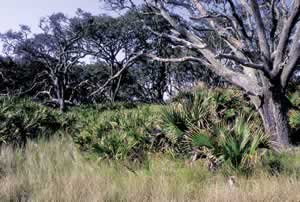
Despite having poorer soil than other eastern coastal regions, Georgia's barrier islands are home to hundreds of plant species. These plants, which are spread throughout each community (the beaches, marshes, maritime forests, and sloughs), are quite hardy and have adapted to survive extreme conditions. While high salt concentrations, quick water drainage, and shifting sand that exist in the upper beach and primary dune areas foster poor plant growth, the low-lying swale portions of the beach allow for better plant growth. This is because swales are closer to ground water and are less disturbed by high salinity winds.
Salt marshes are home to the highest number of plants, with grasses, shrubs, and glasswort occupying much of the marshland. The predominant plant species is Spartina alterniflora, smooth cordgrass. It is a constant food source for many species. Low marshes, again because of high salinity levels, provide limited plant growth.
Cabbage palms outline the marshes giving way to maritime forests, which are occupied by magnolias, pines, woody vines, red bay, holly, sparkleberry, saw palmettos, resurrection ferns, and many other species. Because plant decay is sped by high humidity and extremely hot temperatures, the soil is constantly replenished with nutrients. These nutrients are readily accepted by the shallow root systems of the majority of these plants and trees.
While constantly changing water levels in sloughs bring unfortunate demise to much of the wildlife, the dead organisms are beneficial to the nutrient-poor soil. Because forested areas are usually heavily canopied, sloughs found in these areas last for much longer periods and are very beneficial to wildlife.
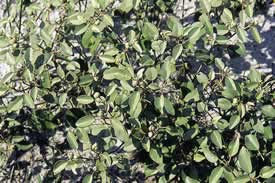
Croton punctatus, which grows to about 3 feet tall, is a shrub unlike any other found among Georgia's sand flats. Stellate hairs cover all but the upper surface of the plant's leaves, which are egg-shaped or oblong, and a tiny red spot can be seen in the middle of each hair cluster. This shrub is sometimes referred to as a silver-leaf croton.
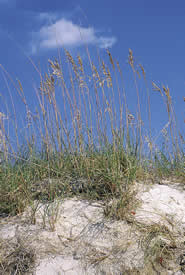 Sea
Oats
Sea
OatsSea oats, Uniola paniculata, are extremely important to Georgia's beaches. This perennial grass helps in sand dune-building and stabilization and is therefore protected. In Georgia, as well as other states, it is considered a misdemeanor to pick this plant. Other sand dune stabilization plants include panic grass, wild morning glories, and some cord grasses.
Sea oats are quick-growers and reach heights of 3 to 7 feet. They are found clustered together along the upper sand ridges. They have brownish scales that are grouped into spikelets on smooth, long, erect stems. The leaves of the sea oat are long, wide, and smooth, and its fruit is a compressed grain, which peaks in late June or early July. The leaves and tall oat heads trap wind-blown sand and help in the process of dune-buildling. Sea oats also grow vertical runners, producing daughter plants on top of growing dunes.
There are three species of yucca plants in the Agave family, or Agavaceae, and all three are recognized in Georgia. They are the mound-lily yucca, Yucca gloriosa; Spanish bayonet, Yucca aloifolia; and the bear-grass yucca, Yucca flaccida. Spanish bayonet is by far the most abundant along Georgia's coast. Each species can be found in marshes, dunes, or thin woods. Classified a shrub or small tree, these plants may reach 6 feet tall and each displays rigid, bladed leaves. Its bell-shaped flowers cluster at the top of the plant and can be seen in the spring.
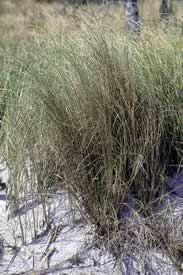
Found throughout the coastal islands, cordgrasses, or Spartina, dominate the salt marshes. However, the most prominent cordgrass species is Spartina alterniflora, which grows in three different classifications: tall, medium, and short. Tall cordgrass grows along the banks and streamside; medium cordgrass congregates in the middle marsh at the end of creeks; and short cordgrass grows on the high marshland or in lower, more stagnant waters.
Alterniflora cordgrasses produce copious amounts of organic material and are uniquely able to tolerate saline water, hot temperatures, and an unstable substrate that is anaerobic. Cordgrasses have a C4 plant type classification, meaning they use a photosynthetic pathway that nearly completely avoids photorespiration. The organic material these grasses produce is extremely beneficial to the estuary community. Because these grasses contribute up to 80 percent of the total primary organic production, the cordgrass populations are important to the coastal food chain.
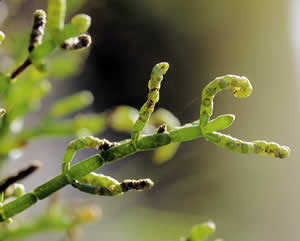 Glasswort
GlasswortThere are two main variations of Salicornia species noted on the Georgia coast: the Salicornia europaea, or common glasswort, and the S. virginica, which is much less common. Common glasswort is a low-growing, erect, annual herb grass and is generally found in tidal marshes, though it is sometimes found in tidal pools. Its stems, which grow between 4 to 20 inches tall, are fleshy and jointed with many branches. Two major characteristics of the common glasswort are an absence of foliage and a deep red color displayed in the fall. S. virginica is found close to S. europaea; however, in the fall S. virginica usually remains green.
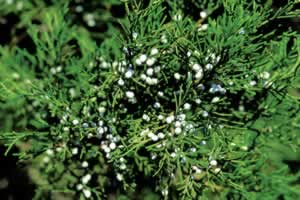
Juniperus virginiana, or red cedar, is a member of the cypress family, Cupressaceae, and it occurs primarily in dry, open places or thinly wooded areas. Many times it is seen bedded in a live oak forest. The red cedar is a small, aromatic, evergreen tree with brownish, scaly bark. Its leaves can be opposite and scalelike or fat and triangular, with both leaf types sometimes occurring on the same tree. The female seed cones of a red cedar tree mature after about a year and resemble small whitish berries. Male cones are formed on separate trees. Their flowering season occurs from January through April. A variety of the J. virginiana, the J. silicicola, or southern red cedar, is a smaller version of the tree occurring in either dry or wet areas. However, it is much less common along Georgia's coast.
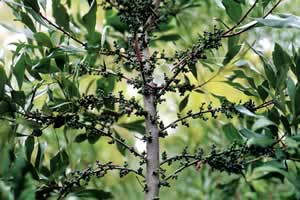 Wax
Myrtle
Wax
MyrtleMyrica cerifera, or wax myrtle, is a broadleaf evergreen shrub or tree frequently found in the upper edges of salt and brackish marshes as well as in nontidal swamps. It grows along the entire Georgia coast; however, it tends to be most abundant in the southern half of the islands, most likely because of its high tolerance for balmy, humid temperatures, which increase closer to Florida. The wax myrtle usually reaches heights of 10 to 15 feet, but it may grow as tall as 36 feet. Its bark is smooth and grayish-green, and its oblong-shaped leaves are rather large and fragrant. The twiglike branches are mostly hairless but may have a few scattered hairs. The wax myrtle bears both the female and male flower, called catkins, during its flowering period of March to June. The male catkin is oval and the female is linear, round, and waxy.
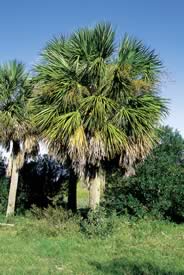
The Sabal palmetto is an evergreen palm tree that grows up to 75 feet tall. Its trunk is unbranched with dark gray, rough bark and it bears fanlike leaves at the top. These leaves are stiff, green, and compound and may grow up to 7 feet wide and long. Its tubular white flowers are about 0.2 of an inch long and during its flowering season of June and July, they add a sweet fragrance to the salty marsh air. Though it is used for landscaping, it claims moist flatwoods and maritime forests as its natural habitat. It is particularly plentiful in the lower half of Georgia's coastline and is the only tree-like palm on the coast. The heart of a cabbage palm is edible, and the Guale Indians boiled it in bear fat for porridge.
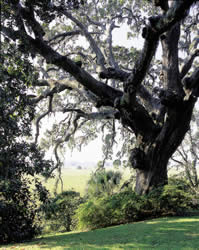 Live
Oak
Live
OakThe history of Quercus virginiana dates back to the shipbuilding days of the coast, when the tree's "iron strong" branches were highly demanded for production of great ships such as Old Ironsides. These massive evergreen trees, sometimes reaching 60 to 70 feet tall, occur mostly along the sandstone ridges, tidal swamps, and forested wetlands. Their gnarly branches, which expand outward over 50 feet, form a dense canopy that shades forests. The tree's bark is dark to reddish brown and well grooved. Its egg-shaped leaves are small and they are tough and shiny above and gray and somewhat hairy below. Shedding its leaves in early spring, it is not unusual to see the ground covered in leaf cover as much as a few inches thick.
Among Georgia's coastal trees, the live oak could easily be picked as the "granddaddy" tree. Because of its gnarly branches, the tree appears quite old though it may still be quite young. Draping from these trees are abundant amounts of Spanish moss, which enhance this aged appearance. A host of other plants and animals, which are attracted to the leaf dust and mold within the wet grooves, also reside among the branches.
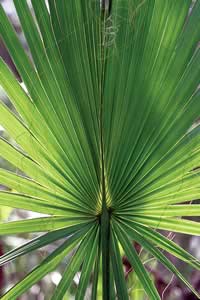
A staple of Georgia's coastal forests, Serenoa ripens is a distinctive aromatic plant that is easily recognized by its evergreen, spiny, fanlike leaves. It is commonly seen growing in the understory of live oaks or in pine forests. Its leaves are bright green to bluish-green, and the leaf base often hides the somewhat exposed stem along the ground. Its fruit is a drupe usually occurring in March through early July.
This erect, green-leafed fern commonly resides in the coastal forests and marshes and is usually seen lining the lower branches of the trees, particularly rough-barked ones. One of its favorite trees is the live oak, as the fern takes especially well to the dust and leaf mold. Polypodium polypodioides appears almost dead in the dry winter, curling inward and turning grayish. But during rainy spring and summer seasons, it revives again-hence its name, "resurrection" fern. However, it takes a long time for this fern to dry out, and it can thrive for extended periods when water supplies are scarce.
Magnolia grandiflora, one of the best-known southern trees, is found clustered throughout the islands near oak trees. Most of the magnolias are quite large with rather fragrant, grandiose flowers. Its well-known fragrance is a wonderful addition to the islands' other aromatic plants, such as the osmanthus, saw palmetto, and palm flowers.
In all magnolias, when the stipule drops, distinctive scars are exposed on the small branches. Magnolias produce a conelike fruit, which bears red berry seeds, often eaten by birds and other animals.
 Spanish
Moss
Spanish
MossBecause of its love for the live oak tree, Tillandsia usnesides is often considered very much a part of the tree's existence, aiding in its already old age appearance (thus the street name of the moss, "Old Man's Beard.") It is described best by Archie Carr in A Naturalist in Florida, A Celebration of Eden: "The festoons fall in soft tapers that are opaque gray above and thin out into translucent spikes below...A woods without moss stands still in a tempest and only tosses its branches about, but when moss is out there flying with the wind the woods seem to be in motion, like landscapes seen through the window of a running train." The abundant festoons provide a great habitat for many island birds and small mammals. Though it is gray and crinkly when dry, it becomes very green and furry following a summer rain. Because of its absorbent nature, the plant retains a very strong, aromatic, salty wood smell, which is a distinguishing characteristic of Georgia's coastal air.
Despite popular belief, Spanish moss is not a parasite; it is a "tenant." It often chooses oak trees because of more favorable conditions. In reality, moss survives by gathering moisture and minerals from blown-in dust and the air and produces food with the help of chlorophyll and sunlight.
Since the Indians occupied coastal Georgia more than 4,500 years ago, the surrounding environment and the rich, productive land that brought them here have changed-and not changed. Despite population growth and industrial development over the past several decades, Georgia's coast remains, "...the fairest, fruitfullest and pleasantest of all the world," to quote the French discover, Captain Jean Ribault.
Environmentalists and legislators alike have provided measures to conserve the natural habitat of the coast, particularly along the waterfront, where the most development has occurred. In addition, some wetlands and state and federal lands are protected from development.
Coastal animal life among the four major barrier island ecosystems (the ocean beach, salt marsh, maritime forests, and freshwater sloughs) is plentiful. However, the animals must be able to survive under high temperatures which last for longer periods, high salinity, and constant shifts in the sand. Although these conditions can make it tough for the fauna, they have found ways to adapt.
For most of the fauna of the sand beaches, survival is dependant upon their ability to burrow into the sand, allowing for more stable conditions for feeding, breathing, and reproducing, as well as providing protection from predators. This especially holds true for fauna in the intertidal regions of the beaches.
The shrub zones and maritime forests, with their abundant plant life, are a constant source of food and shelter for land animals. Freshwater sloughs provide much-needed fresh water for many fauna including fish, amphibians, birds, water snakes, and insects.
The animals in salt marshes are exposed to high concentrations of salt and rapid temperature changes. However, these difficult conditions occur less in the levee and low portions of the marshes, leading more aquatic animals to live there. While overall the salt marsh is less hospitable as a permanent home, animals depend on the marsh for temporary shelter and feeding opportunities.
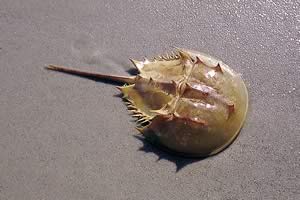
The Limulus polyphemus, horseshoe crab, is frequently found lying on Georgia's beaches. It lives in near-shore bays and estuaries and in deeper waters, and it enters shallow water for breeding, the male riding atop the larger female. It is not a true crab; instead it is more closely related to the scorpion and sea spider. Horseshoe crabs are considered "living fossils" that have remained virtually unchanged for hundreds of millions of year. The crab's common name is derived from its horseshoe-shaped upper body.
The horseshoe crab's lengthy pincers and spiked abdomen give the impression that it is a fierce creature; however, this is not at all the case. Its pincers are quite weak and are used primarily to gather small clams, worms, and crustaceans for food. The mouth and its several pairs of appendages are on the lower surface. Under its abdomen, there are flat book gills consisting of numerous thin layers, which are used to absorb oxygen from the water. It is not uncommon to find large populations of small white flatworms, as well as tiny shrimp, attached to the crab's shell surface.
During the spring mating season, these crabs are often seen traveling in tandem, with the female in front and the smaller male behind. Male crabs' first leg is shaped like a large hook and is used to grasp the female. The hind legs power the creature's movement through the sand. Nearly 80,000 eggs are deposited in large bowl-like depressions in the intertidal region of quiet beaches; however, many of these eggs are consumed by birds, fishes, and various seashore mammals.
The Rallus longisrostris is a medium-sized salt marsh bird, ranging from 14 to 16 inches tall. Its rather sharp facial features are emphasized by its long, pointy bill and small, beady eyes. Sometimes confused with the king rail, which may be seen in the winter where freshwater and salt marshes occur together, the clapper rail, known by natives as the marsh hen, is much grayer in color, and it lacks rusty-colored underparts. Though it often remains hidden from direct view, its voice is distinctive and loud, making a "kek-kek-kek-kek" sound.
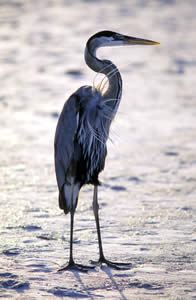 Great
Blue Heron
Great
Blue HeronOften mistaken for a crane because of its gray body and gangly appearance, the Ardea herodias enjoys the shallow banks of Georgia's quieter beaches, such as those of Sapelo and Cumberland islands; however, it is seen throughout all the coastal islands. This intriguing island bird is also found in wetlands among tall trees, rock ledges, and extensive reeds. The great blue heron stands about 4 feet tall, and its underbody is whitish with a black stripe that ends in black plumes behind the eyes. In the breeding adult, gray plumes are at the end of the black-and-white foreneck and chest. Young herons lack plumes and are more brownish in color.
Of the many island birds, great blue herons are among the most standoffish, appearing almost timid at times. While the other species may socialize, these herons are usually found grouped away from the others, keeping a watchful eye on newly laid eggs. These birds lay about three to seven bluish-green eggs at one time, and because of the bright color, these eggs are vulnerable to crows and raccoons. During the early stages of incubation, the adult may leave the nest in search of food, but during the later stages, one of the parents is always present. The nests, which are poorly made of sticks and other materials, must be in clear sight to allow adults a clear landing after a day's search of food.
One distinguishing characteristic of this bird is its shrieking call. It mainly calls when alarmed, and its loud raucous call can be heard from great distances.
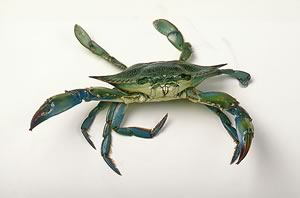
The Callinectes sapidus, the largest of the swimming crab family, Portunidae, supports commercial fisheries along the coast. Crabbing makes up about 10 to 20 percent of Georgia's commercial fishing industry.
The body of the blue crab is flat and wide, and each side has a long point or spike. The front and side margins are saw-toothed, whereas the hind margin is smooth. Its back is usually olive green or greenish-brown with small, almost obscure spots, and its underbody is white. Both the male and female crabs have partially blue legs and claws, but females have orange on the fingers. Many biologists believe that the body colors help to camouflage the animal from predators, allowing it to more easily blend in with the water and other marine life. Female blue crabs generally live offshore, whereas juveniles are usually found in the marshes. While it is nearly impossible to confuse the adult blue crab with crab species outside its genus, closer observation is required to tell it apart from more closely related species. Even experts may have difficulty distinguishing some species.
Mating occurs in the upper estuaries in low salinity water. Though the males remain behind, females spawn in high salinity lower estuaries or in the nearby ocean where eggs hatch into planktonic larvae. These larvae begin to develop in the sea before migrating into estuaries where they eventually become mature adults.
Like the horseshoe crab, the blue crab serves as a host to white flatworms and several other commensals, which attach to its shell. Blue crabs eat a varied diet and are predators, attacking many species of animals, including fiddler crabs, by hiding just beneath the shallow edge of tidal creeks and surprising their prey as it passes by.
 Shrimp
ShrimpEstuaries are filled with shrimp, which are the largest economic fishery for Georgia, making up about 70 to 75 percent of the commercial fishing industry. The most common shrimp varieties are white shrimp, Penaeus setiferus, and brown shrimp, P. aztecus. Pink shrimp, P. duorarum, are much less abundant and make up less than 1 percent of the commercial shrimping business. The total shrimp fishery for Georgia is worth about $180 to $185 million.
Shrimp are measured according to count per pound, and at 10 to 15 per pound, brown shrimp are by far the largest shrimp harvested in Georgia. White shrimp are generally harvested at about 21 to 25 per pound, and are in season from January through the end of June. Brown shrimp have a short season of July and August. According to the Department of Natural Resources, about 450 shrimping licenses are distributed annually, and about 70 percent of those are given to Georgia shrimpers.
The ghost shrimp, Callianassa biformis, which is fairly common but not commercially harvested, is not a true shrimp. It is more closely related to the hermit crab and has an elongated body that is flattened from top to bottom, instead of from side to side like the bodies of true shrimp. With pistonlike abdominal appendages, it pumps water through a sand or mud burrow system and is responsible for the numerous small holes in the sand. It is an offshore animal and lives in marshes.
Members of the wedge clam family, Donaciae, are small clams that live in the sandy surf of outer beaches. The most familiar in the intertidal portion of Georgia's coastal beaches is the Donax variabilis, or coquina clam. As an adult, this attractive clam is about 8 inches long, and it may be seen in a variety of pastel colors. Like mole crabs, coquinas are filter feeders that live in sand and migrate up and down the beach to maintain optimum position with respect to the waterline. Several fishes as well as ghost crabs, speckled crabs, and others prey on the coquina clam. The coquina clam does not allow itself to be carried by ebbing tides and instead remains burrowed near the beach waterline, perhaps to avoid crowding by mole crabs or predation.

Crassostrea virginica is a member of the oyster family, Ostreidae, which includes epibenthic species-meaning that they attach permanently by the shell to hard substrata, often to other oysters. The Eastern oyster, C. virginica, is the most dominant of two common species on the coast of Georgia. The other is the horse oyster, Ostrea equestris. This large creature is primarily intertidal and resides in sounds, estuaries, salt marshes, and tidal creeks. Very tolerant of low salinity water, the Eastern oyster often forms large reeks on mud, sand, or rocks. It has long, grey, irregular, asymmetric valves, one of which is cemented to a hard surface. The muscle scars of the glossy white interior are purple, and there is a row of small teeth around the inner margins of the valves. Because the edges of the shells are very thin and razor sharp, they must be handled cautiously.
Oysters are harvested in huge quantities nationally; however, over the years, Georgia's oyster fishery has greatly declined. In the early 1900s, Georgia produced more oysters commercially than any other state; however due to pollution and the introduction of minimum wage laws, oyster harvesting suffered. (Before the minimum wage laws went into effect, oyster pickers were paid by the number of oysters picked; with the new law, the incentive to harvest great numbers of oysters greatly decreased.) Today, Georgia's oyster fishery is worth only about $100,000. Because of this, it is rare to find Georgia oysters offered on the menu in coastal restaurants; generally, these oysters are brought in from Florida, Texas, or Louisiana.
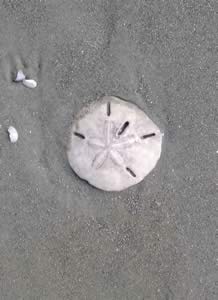 Sand
Dollar
Sand
Dollar Probably one of the most popular findings of all beachcombers, the Mellita quinquiesperforata has been a longtime beach inhabitant. Most often found on the shores however, are dead sand dollars that have washed up in the tides. Contrary to popular belief, these sun-bleached, grayish-white corpses are not representative of the live creature. Dead sand dollars are smooth with highly conspicuous flowerlike patterns on the upper surface. Live creatures are covered with brown felt of very short spines, and the flowerlike pattern is only faintly visible.
These flattened cousins of sea urchins remain buried just below the surface while moving slowly through the sand. Feeding on diatoms and sand coated with organic materials, the sand dollar has special tube feet to help transport food particles to the mouth, which is located on the underbody. Five hard, bird-shaped jaws then crush the diatoms and sand before it enters the stomach.
There are five openings in the lunules that help the sand dollar survive in several ways. First, these openings help prevent the sand dollars from being washed out of the sand by reducing the chance of a hydrodynamic lift imparted to winglike dollars by the water current. Second, these lunules may be shortcuts for transporting its food from the upper side to its mouth on the lower side. And third, the openings allow sand to pass upward as the dollar burrows down.
The right whale, Balaenidae, is one of the most studied marine animals that travel Georgia waters-probably because it is the most rare whale species in the world and therefore protected. There are only about 300 right whales today. This North Atlantic native is characterized by long and narrow baleen plates, known as whalebone, and a highly arched upper jaw. Other distinctive features include its unusually large head that measures more than a quarter of the entire body length; its long, thin snout; its huge lower lips; and its fused neck vertebrae. The skin over the whale's throat is smooth, and it has no dorsal fin. Right whales reach adulthood at about 10 years of age, with females giving birth about every three to five years.
Migration begins in early December, as the whale makes its way from the North Atlantic to Georgia and Florida for birthing and the early months following. It is thought the whales come to Georgia's coast because of the warmer water temperature and relatively calm waters. Warmer water temperatures are especially favorable for newly born calves because they lack much blubber at birth. According to statistics from the Georgia Department of Natural Resources, there were 48 individual right whales seen in 1997. Of those, six were calves and at least one was an adult male. Right whales usually stay in southern waters until about mid-March.
In 1985, the right whale became the official Georgia marine mammal. This declaration
has brought special attention to protecting the whale from its No. 1 man-caused
killer: collisions with ships. Several years ago, the Department of Natural
Resources implemented an early warning system for ships, reducing the risk of
collisions with these slow-swimming creatures. Thus far, the system has proved
to be quite effective, according to Mike Harris, a wildlife biologist with the
Georgia Department of Natural Resources.
The right whale is one of about 17 species of whales noted in Georgia waters.
The manatee is one of two kinds of marine mammals commonly referred to as sea cows. The other is the dugong, and both belong to the family Trichechidae. Migrating to Georgia's waters, including upper estuaries and rivers, is the West Indian manatee, Manatus latirostris. This slow-moving mammal is the largest of three worldwide manatee species, sometimes reaching over 3,000 pounds and 14 feet in length. In Georgia, the largest recorded manatee was about 2,000 pounds and over 10 feet long, according to Barb Zoodsma, a wildlife biologist with the coastal office of the Georgia Department of Natural Resources.
Manatees are believed to be descendants of elephant ancestors, which would account for their enormous size. The manatee has no hind legs, and its front limbs are actually paddles. Its tail is large and bears horizontal flukes similar to those of whales.
Though manatees eat a variety of vegetation, in Georgia they feed primarily on smooth cordgrass in the salt marshes, wild cut rice, and even algae on docks. An interesting characteristic of this creature is that its molar teeth continually move forward in the jaws, with the oldest teeth being shed as new ones erupt at the back of the tooth-rows. The exact reason this sea creature found its way to Georgia is unknown, but the development of the intercoastal waterway in the 1930s probably aided in its migration here. Generally, the manatee is more commonly found in middle to south Florida. The warm water temperature in the spring and summer provides for migration to Georgia, and a small number of manatees remain in the state through the winter months. They are probably able to stay due to the warm water released by paper mills. An endangered species, the manatee is protected.
The Suaenops ocellatus is the second largest recreational fishery is Georgia, with spotted sea trout being the first. The red drum is generally found inshore during the summer; however, it occasionally enters fresh water. Adult fish move in schools during spring and fall to the outer reefs; however, exactly when it moves out depends on temperature, salinity, and food availability. Juvenile fish generally remain closer inshore, even during the winter.
The red drum is the fastest growing fish found in Georgia. It usually grows to 14 inches within its first year of life, and it is considered mature at 27 inches, which it reaches at about four or five years of age. At maturity, it may weigh as much as 90 pounds. Its body is elongated and moderately compressed with a ventral profile that is nearly straight. Its scales are large and are iridescent silvery gray, copper bronze, or reddish, with one or more large, black, ocellated spots on the caudal peduncle. Its dorsal and caudal fins are dusky and anal and levic fins are pale. The larger red drums are sometimes called bullreds, and smaller ones are called ratreds.
The Georgia fish and game code has strict minimum and maximum size limitations for red drum fishing. Anglers may only keep those fish measuring 14 inches, and no more than 27 inches. In addition, there is a five fish limit. These laws are designed to allow the fish to properly mature during the three-year span from juveniles into adults. According to the Department of Natural Resources, there would be too much fishing pressure during that three years, threatening the overall red drum population, if the law was not in place.
Read and add comments about this page
Go back to previous page. Go to Barrier Islands contents page. Go to Sherpa Guides home.
[ Previous Topic | Next Topic ]